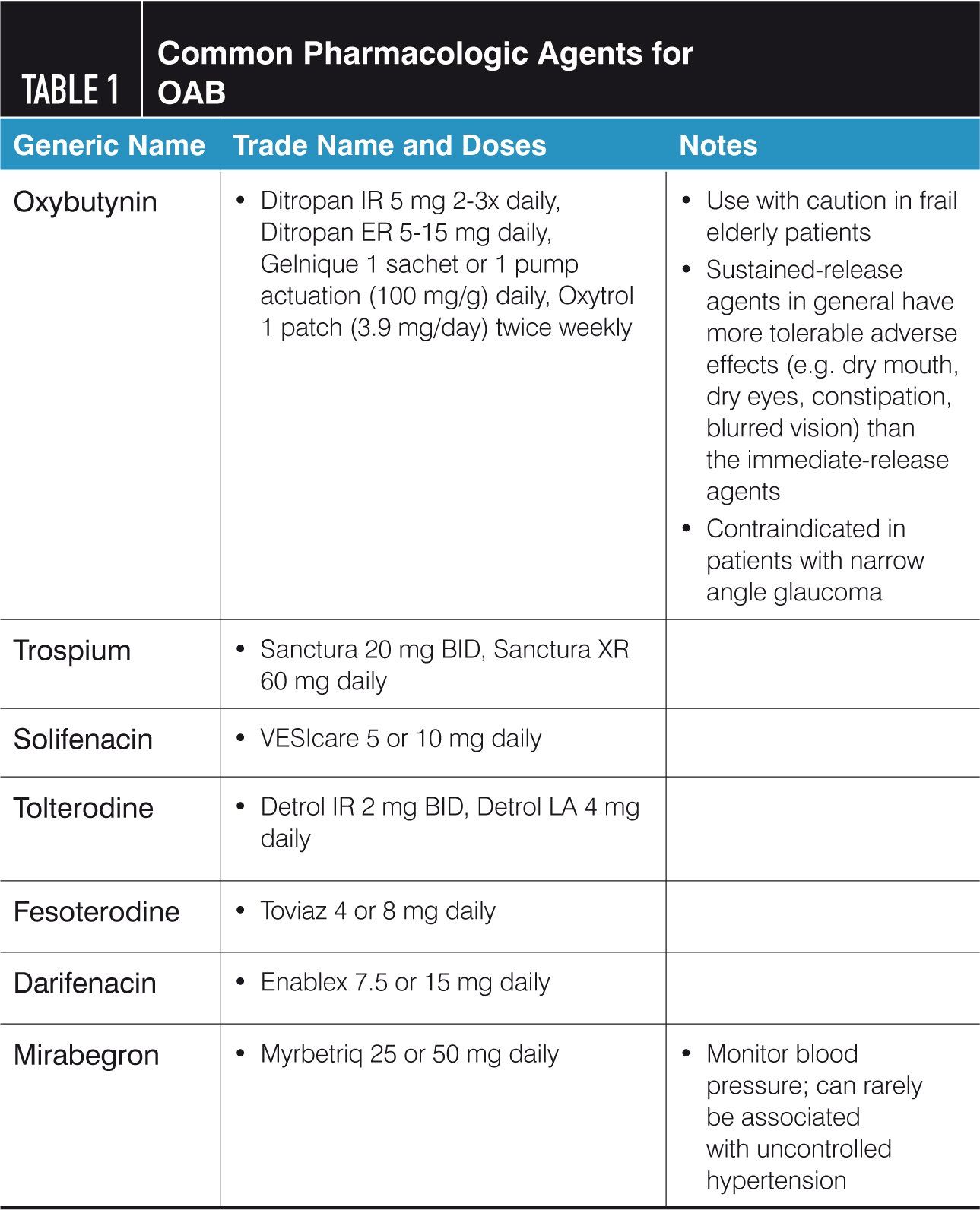Overactive bladder: Special considerations across a woman’s life span
This article summarizes guidelines for diagnosis and treatment, highlighting special considerations for management of OAB across a woman’s life span.
Judy Yeh, MD

Toby C. Chai, MD

Introduction
Bladder health is an important component of a woman’s well-being,1 and overactive bladder (OAB) remains a multifactorial symptom complex that gynecologists are uniquely positioned to address. This article summarizes guidelines for diagnosis and treatment, highlighting special considerations for management of OAB across a woman’s life span.
Diagnosis and workup
The diagnosis of OAB is established clinically. The International Continence Society (ICS) defines OAB as a syndrome with symptoms of urinary urgency, with or without
urge incontinence, usually with frequency and nocturia,2 in the absence of urinary tract infection (UTI) or other obvious pathology.
Urgency is defined as the complaint of a sudden compelling desire to pass urine, which is difficult to defer. Urge incontinence is defined as the complaint of involuntary leakage of urine accompanied by or immediately preceded by urgency. Increased daytime frequency and nocturia are determined by patient bother per ICS definitions, without needing to meet a certain threshold for number of voids.3 As a reference for what is considered “normal,” median voiding frequency is determined to be every 3 to 4 hours during the day and 1 or fewer during sleep at night, based on a cross-sectional, epidemiologic study involving more than 4,000 community-dwelling women aged 25 to 84.4
The American Urological Association (AUA) and Society of Urodynamics, Female Pelvic Medicine & Urogenital Reconstruction (SUFU) have published guidelines regarding diagnosis and treatment of non-neurogenic OAB5: history, physical exam, and urinalysis (to rule out urinary tract infection and hematuria) at a minimum, with the addition of urine culture, post-void residual assessment, bladder diary, and/or symptom questionnaires at the clinician’s discretion. Urodynamics, cystoscopy, and diagnostic renal and bladder ultrasound should not be used in the initial workup of the uncomplicated patient.
Treatment
Patient education is key. Clinicians should include as part of their counseling information that acceptable symptom control may require trials of multiple therapeutic options. Treatment should be offered only if a patient’s symptoms are bothersome. Behavioral therapies are considered first-line treatment and include bladder training, bladder control strategies, pelvic floor muscle training, weight loss, avoidance of caffeinated beverages/alcohol and fluid management. Considered second-line treatment, pharmacologic management may be combined with behavioral therapies. Pharmacologic agents include antimuscarinics (oxybutynin, trospium, solifenacin, tolterodine, fesoterodine, darifenacin) and β3-adrenoceptor agonist (mirabegron) (Table 1); extended-release formulations are generally recommended over immediate-release formulations because of lower rates of dry mouth. Oxybutynin is available over the counter in a transdermal formulation. Management of dry mouth and constipation should be attempted before abandoning effective therapy. Follow-up should be offered and encouraged to assess compliance, efficacy, side effects, and possible alternative treatments.

When to refer
Refractory OAB is defined as failure of a trial of symptom-appropriate behavioral therapy of sufficient length (at least 8 to 12 weeks) and failure of a trial of at least one antimuscarinic medication (based on lack of efficacy and/or inability to tolerate adverse drug effects) administered for at least 4 to 8 weeks.6 Patients whose OAB is refractory to behavioral and pharmacologic therapy should be evaluated by an appropriate specialist if they desire additional therapy.
Special considerations across a female life span
The overall prevalence of OAB is estimated to be 17% for women in the United States and increases with age, rising to > 30% in those over 65.7 Highlighted below are special considerations specific to different stages of a woman’s life span.8 Because OAB and UTI may manifest with similar symptoms, clinicians should rule out UTI prior to diagnosing or treating OAB. UTI is common in women of all ages,9 especially with the onset of sexual activity and pregnancy during reproductive years.10
Childhood and adolescence
Childhood lower urinary tract symptoms (LUTS) may be predictive of adult OAB.11 OAB syndrome can occur in childhood as early as age 5, provided toilet training has been achieved.12 Pediatric OAB is often associated with constipation, and symptomatic improvement in LUTS has been demonstrated with treatment of constipation.13 In addition, OAB in childhood and adolescence is often associated with behavioral/psychiatric disorders, notably anxiety, depression, and attention deficit, and conventional treatment modalities for OAB are often ineffective without addressing the underlying neuropsychiatric dysfunction.14
Reproductive years
Any feature of pain associated with urinary urgency should prompt inclusion of interstitial cystitis/bladder pain syndrome (IC/BPS) in the differential diagnosis.15 In a prospective cohort study of more than 7,000 community-dwelling women, OAB was found to be significantly associated with obesity, smoking, and consumption of carbonated drinks.16 Lifestyle and behavioral modification such as weight loss has been shown to reduce episodes of urinary incontinence.17
Menopause
Estrogen deficiency has been implicated in the etiology of LUTS postmenopause, with 70% of women relating the onset of urinary incontinence to their final menstrual period.18 The role of estrogen therapy in the management of postmenopausal OAB remains controversial; vaginal estrogen therapy can be considered if urogenital atrophy is detected on physical exam.19 For urogenital atrophy, common vaginal estrogen supplementation regimens include Estrace 100 µg/g or Premarin 0.625 mg/g 0.5-2 g daily for 1 to 2 weeks, then twice weekly; Vagifem 10 µg/tablet one tablet intravaginally daily for 1 to 2 weeks, then twice weekly; and Estring 7.5 mcg/day ring replaced every 90 days.
In elderly women, urge incontinence is independently associated with falls and factures.20 Pharmacologic therapy should be used with caution in the frail patient, and the AUA/SUFU guidelines advocate for placing a greater emphasis on behavioral strategies to include prompted voiding and fluid management. Use of medications with anticholinergic effects has been associated with dementia in the older individuals.21 Imaging of the brain in older patients on anticholinergics found increased atrophy, in addition to clinical measures of decreased cognitive abilities.22 Clinicians should judiciously use medications with anticholinergic activity in elderly patients.
Conclusion
While generally not life-threatening, OAB can compromise quality of life and perpetuate bother. Gynecologists play a special role in managing OAB and promoting bladder health across a woman’s life span. First-line therapy in all ages is conservative treatment including behavioral and fluid management strategies. Second-line therapy involves use of pharmacologic agents including antimuscarinics and β3-agonist. If a patient’s OAB fails to respond to second-line therapy, she should be referred to a specialist for further evaluation and management.
Disclosure The authors report no potential conflicts of interest with regard to this article.
REFERENCES
1. Mueller ER, Damaser MS, Mallampalli MP, Losada L. Women’s Urological Health as a Priority to the Woman Well Visit. Womens Health Issues 2016;26(4):476-7.
2. Abrams P, Cardozo L, Fall M, et al. The standardisation of terminology of lower urinary tract function: report from the Standardisation Sub-committee of the International Continence Society. Neurourol Urodyn 2002;21(2):167-78.
3. Irwin DE, Abrams P, Milsom I, Kopp Z, Reilly K. Understanding the elements of overactive bladder: questions raised by the EPIC study. BJU Int 2008;101(11):1381-7.
4. Lukacz ES, Whitcomb EL, Lawrence JM, Nager CW, Luber KM. Urinary frequency in community-dwelling women: what is normal? Am J Obstet Gynecol 2009;200(5):552.e1-7.
5. Gormley EA, Lightner DJ, Burgio KL, et al. Diagnosis and treatment of overactive bladder (non-neurogenic) in adults: AUA/SUFU guideline. J Urol 2012;188(6 Suppl):2455-63.
6. Gormley EA, Lightner DJ, Faraday M, Vasavada SP. Diagnosis and treatment of overactive bladder (non-neurogenic) in adults: AUA/SUFU guideline amendment. J Urol 2015;193(5):1572-80.
7. Stewart WF, Van Rooyen JB, Cundiff GW, et al. Prevalence and burden of overactive bladder in the United States. World J Urol 2003;20(6):327-36.
8. Losada L, Amundsen CL, Ashton-Miller J, et al. Expert Panel Recommendations on Lower Urinary Tract Health of Women Across Their Life Span. J Women’s Health 2016;25(11):1086-1096.
9. Ellsworth P, Marschall-Kehrel D, King S, Lukacz E. Bladder health across the life course. Int J Clin Pract 2013;67(5):397-406.
10. Karram MM. Lower urinary tract infection. In: Ostergard DR, Bent AE, eds. Urogynecology and Urodynamics. Baltimore: Williams & Wilkins; 1991.
11. Fitzgerald MP, Thom DH, Wassel-Fyr C, et al. Childhood urinary symptoms predict adult overactive bladder symptoms. J Urol 2006 Mar;175(3 Pt 1):989-93.
12. Austin PF, Bauer SB, Bower W, et al. The standardization of terminology of lower urinary tract function in children and adolescents: update report from the Standardization Committee of the International Children’s Continence Society. J Urol 2014;191(6):1863-1865.e13.
13. Loening-Baucke V. Urinary incontinence and urinary tract infection and their resolution with treatment of chronic constipation of childhood. Pediatrics 1997;100(2 Pt 1):228-32.
14. Franco I. Overactive bladder in children. Nat Rev Urol 2016;13(9):520-32.
15. Cardozo L, Robinson D. Special considerations in premenopausal and postmenopausal women with symptoms of overactive bladder. Urology 2002;60(5 Suppl 1):64-71.
16. Dallosso HM, McGrother CW, Matthews RJ, Donaldson MM. The association of diet and other lifestyle factors with overactive bladder and stress incontinence: a longitudinal study in women. BJU Int 2003;92(1):69-77.
17. Subak LL, Wing R, West DS, et al. Weight loss to treat urinary incontinence in overweight and obese women. N Engl J Med 2009;360(5):481-90.
18. Iosif CS, Bekassy Z. Prevalence of genito-urinary symptoms in the late menopause. Acta Obstet Gynecol Scand 1984;63(3):257-60.
19. Robinson D, Cardozo L, Milsom I, et al. Oestrogens and overactive bladder. Neurourol Urodyn 2014;33(7):1086-91.
20. Brown JS, Vittinghoff E, Wyman JF, et al. Urinary incontinence: does it increase risk for falls and fractures? Study of Osteoporotic Fractures Research Group. J Am Geriatr Soc 2000;48(7):721-5.
21. Gray SL, Anderson ML, Dublin S, et al. Cumulative use of strong anticholinergics and incident dementia: a prospective cohort study. JAMA Intern Med 2015; 175(3):401-7.
22. Risacher SL, McDonald BC, Tallman EF, et al. Alzheimer’s Disease Neuroimaging Initiative. Association Between Anticholinergic Medication Use and Cognition, Brain Metabolism, and Brain Atrophy in Cognitively Normal Older Adults. JAMA Neurol 2016;73(6):721-32.
A Legacy of Excellence: Reflecting on the Final Print Edition of Contemporary OB/GYN
April 25th 2025Marking the end of an era and the beginning of a new chapter, the final print edition of Contemporary OB/GYN celebrates over 50 years of evidence-based guidance and unwavering support for clinicians.
Read More
